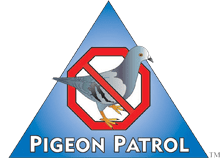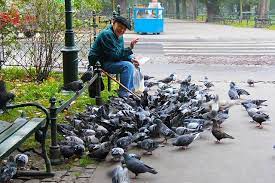
by Pigeon Patrol | May 25, 2021 | Pigeon Control, Pigeon Droppings, Pigeon Spikes, Pigeons
Some folks consider them an endearing part of urban life, others see them as an aggravation, but everyone recognizes this familiar wild neighbor. Pigeons may have been the first bird species to be domesticated, possibly as early as 6,500 years ago. The Egyptians used pigeons to carry the news of the coronation of Ramses III — more than 3,000 years before the United States was founded. Pigeons were well-equipped for this job, as they reach flight speeds of 15 to 60 miles per hour!
The rock dove, as the species also is known, is a European immigrant. Pigeons were introduced to North America by early European settlers. You’ll find pigeons in almost any city, town, or suburb on the continent. Their diet consists primarily of grains and seeds, along with insects and some greens — but pigeons aren’t terribly picky, and they’ll happily accept human food scraps and leftovers when available. From a pigeon’s point of view, city living can’t be beat. Food and water are readily available. Predators are few and far between. Plus, there’s plenty of free housing — pigeons like to live in large groups on window ledges, rooftops, bridges, and warehouses as these offer room for whole flocks to rest or take shelter in close proximity.
Family Life
Pigeons live in groups called “flocks.” Each flock has an equal number of male and female members. A courting male pursues his intended mate on the ground, circling her, with his neck feathers inflated and his tail spread, bowing and cooing all the while. Pigeons mate for life, but if one partner dies the survivor generally will attempt to find another mate.
Pigeons show a strong affinity for human-built structures. Nests, a haphazard combination of twigs, leaves, and a few feathers, are built on window ledges, behind signs, and under bridges. Parents take turns incubating the clutch of one or two white, unmarked eggs for between 16 and 19 days. After the eggs hatch, both parents feed the baby pigeons, or squabs, a crop secretion called “pigeon milk,” which is produced from the lining of the crop, a sac-like food storage chamber located under the bird’s esophagus. The milk is a highly nutritious and an efficient way of feeding young. Squabs fledge at four to six weeks of age but remain dependent on their parents for as long as the adults will tolerate them — generally another one or two weeks. Individuals may be capable of breeding at six months of age.
Pigeons leave their nesting and roosting sites during daylight hours to search for food, but they return at night, as well as periodically during the day when raising young.
Found an injured or orphaned pigeon?
Wildlife rehabilitation centers provide care for injured and orphaned wildlife until the animal can be released back to the wild. In most states, wildlife rehabilitation can be practiced only with a state and/or federal license.
Adult pigeons may suffer from broken bones, parasite infestations, and diseases, some of which may present a human health hazard. Without proper intervention, these birds may die from their injuries or be permanently disabled. Rehabilitators receive the special training needed to assess these problems and offer appropriate aid.
Baby pigeons may be covered with sparse, fuzzy down or spiky, emerging feathers, and their beaks can look rather deformed. Like all other infants, squabs have unique nutritional requirements. Baby bird food available at pet stores may claim to be appropriate for all birds, but this is simply not true. Furthermore, squabs must be fed through a tube inserted into their crop several times a day – a risky procedure even for experienced wildlife rehabilitators. Problems that result from an inappropriate diet, such as metabolic bone disease (also known as rickets), can debilitate an animal for life.
If you’ve found a pigeon in need of assistance, contact a wildlife rehabilitator.
Read more about orphaned or injured wildlife.
POSSIBLE CONFLICTS & SOLUTIONS
At first glance, the arrangement we have with pigeons appears to be ideal; we provide room and board and in return the birds add a little warmth and color to our cold concrete canyons. So what’s the problem? In a word — droppings.
Not only is pigeon poop unsightly, it can damage buildings, monuments, and automobiles, and if allowed to accumulate, human health problems may arise. A little patience and understanding go a long way toward resolving these problems. Removing the animals in question may seem like an obvious answer. The truth, however, is that results with this approach are short-lived because removal simply creates a vacancy that other animals quickly fill. Humane conflict prevention and resolution is less expensive and more effective in the long run. People can live in harmony with wildlife – you just have to know your wild neighbors!
Roost inhibitors, distress call devices, predator-shaped kites and scarecrows, and netting are effective and humane ways to prevent and/or solve most conflicts with pigeons. Go to our humane exclusion resources page to find vendors that sell these devices.
PUBLIC HEALTH CONCERNS
Pigeons are known carriers of cryptococcus and salmonella. However, there is little evidence linking pigeons directly to infections in humans.
Information about humane prevention of pigeon conflicts was prepared by Kieran Lindsey, Natural Assets Consulting, and reviewed by Richard F. Johnston, Ph.D., Professor Emeritus, Natural History Museum, University of Kansas.
Source
Pigeon Patrol Products & Services is the leading manufacturer and distributor of bird deterrent (control) products in Canada. Pigeon Patrol products have solved pest bird problems in industrial, commercial, and residential settings since 2000, by using safe and humane bird deterrents with only bird and animal friendly solutions. At Pigeon Patrol, we manufacture and offer a variety of bird deterrents, ranging from Ultra-flex Bird Spikes with UV protection, Bird Netting, 4-S Bird Gel and the best Ultrasonic and audible sound devices on the market today.
Voted Best Canadian wholesaler for Bird Deterrent products ten years in a row.
Contact us at 1- 877– 4– NO-BIRD, (604) 585-9279 or visit our website at www.pigeonpatrol.ca
Pigeon/Pigeon Patrol / Pigeons Roosting / Vancouver Pigeon Control /Bird Spikes / Bird Control / Bird Deterrent / Pigeon Deterrent? Surrey Pigeon Control / Pest /Seagull deterrent / Vancouver Pigeon Blog / Birds Inside Home / Pigeons in the cities / Ice Pigeons/ What to do about pigeons/ sparrows , Damage by Sparrows, How To Keep Raccoons Away, Why Are Raccoons Considered Pests/ De-fence / Pigeon Nesting/ Bird Droppings / Pigeon Dropping/ woodpecker control/ Professional Bird Control Company/ Keep The Birds Away/ Birds/rats/ seagull/pigeon/woodpecker/ dove/sparrow/pidgeon control/pidgeon problem/ pidgeon control/flying rats/ pigeon Problems/ bird netting/bird gel/bird spray/bird nails/ bird guard
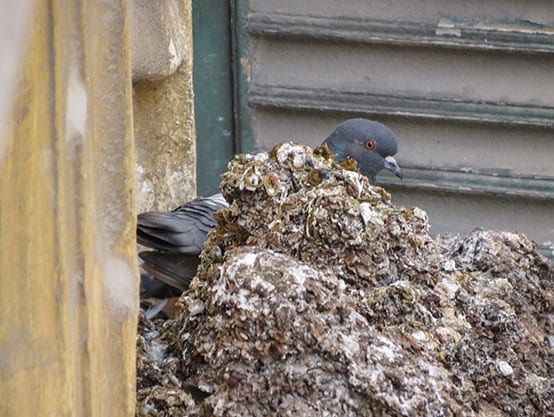
by Pigeon Patrol | May 25, 2021 | Bird Deterrent Products, Bird Law, Bird Netting, Bird Spikes, Pigeon Control, Pigeon Droppings, Pigeon Patrol's Services
When it comes to birds, there may be more than just avian flu to be worried about. It has been suggested that there are over 60 other diseases that birds and their droppings can carry. The problem is especially worrisome in residential areas, as many of them are airborne and can be transferred to humans just by being around droppings.

a pigeon bird standing by guano manure
Chicken farms can be fairly easily secured. With a combination of visual scare devices, sonic distress call emitters, ultrasonic disrupters and roost inhibitors other birds shouldn’t be a problem. If farmers just took this preventative action it could help contain the bird flu outbreak a good deal.
- Histoplasmosis is a respiratory disease that may be fatal. It results from a fungus growing in dried bird droppings.
- Candidiasis is a yeast or fungus infection spread by pigeons. The disease affects the skin, the mouth, the respiratory system, the intestines and the urogenital tract, especially the vagina. It is a growing problem for women, causing itching, pain and discharge.
- Cryptococcosis is caused by yeast found in the intestinal tract of pigeons and starlings. The illness often begins as a pulmonary disease and may later affect the central nervous system. Since attics, cupolas, ledges, schools, offices, warehouses, mills, barns, park buildings, signs, etc. are typical roosting and nesting sites, the fungus is apt to found in these areas.
- St. Louis Encephalitis, an inflammation of the nervous system, usually causes drowsiness, headache and fever. It may even result in paralysis, coma or death. St. Louis encephalitis occurs in all age groups, but is especially fatal to persons over age 60. The disease is spread by mosquitoes which have fed on infected house sparrow, pigeons and house finches carrying the Group B virus responsible for St. Louis encephalitis.
- Salmonellosis often occurs as “food poisoning” and can be traced to pigeons, starlings and sparrows. The disease bacteria are found in bird droppings; dust from droppings can be sucked through ventilators and air conditioners, contaminating food and cooking surfaces in restaurants, homes and food processing plants.
- E.coli. Cattle carry E. coli 0157:H7. When birds peck on cow manure, the E. coli go right through the birds and the bird droppings can land on or in a food or water supply.
Besides being direct carriers of disease, nuisance birds are frequently associated with over 50 kinds of ectoparasites, which can work their way throughout structures to infest and bite humans. About two-thirds of these pests may be detrimental to the general health and well-being of humans and domestic animals. The rest are considered nuisance or incidental pests.
A few examples of ectoparasites include:
- Bed bugs (Cimex lectularius) may consume up to five times their own weight in blood drawn from hosts which include humans and some domestic animals. In any extreme condition, victims may become weak and anemic. Pigeons, starlings and house sparrows are known to carry bed bugs.
- Chicken mites (Dermanyssus gallinae) are known carriers of encephalitis and may also cause fowl mite dermatitis and acariasis. While they subsist on blood drawn from a variety of birds, they may also attack humans. They have been found on pigeons, starlings and house sparrows.
- Yellow mealworms (Tenebrio molitor), perhaps the most common beetle parasites of people in the United States, live in pigeon nests. It is found in grain or grain products, often winding up in breakfast cereals, and may cause intestinal canthariasis and hymenolespiasis.
- West Nile Virus while West Nile is technically not transmitted to humans from birds, humans can get infected by the bite of a mosquito who has bitten an infected bird. The obvious lesson is that the fewer birds there are in any given area, the better. This translates into a smaller chance of an infected bird in that area, a smaller chance of a mosquito biting an infected bird and then biting a human.
Pigeon Patrol Products & Services is the leading manufacturer and distributor of bird deterrent (control) products in Canada. Pigeon Patrol products have solved pest bird problems in industrial, commercial, and residential settings since 2000, by using safe and humane bird deterrents with only bird and animal friendly solutions. At Pigeon Patrol, we manufacture and offer a variety of bird deterrents, ranging from Ultra-flex Bird Spikes with UV protection, Bird Netting, 4-S Bird Gel and the best Ultrasonic and audible sound devices on the market today.
Voted Best Canadian wholesaler for Bird Deterrent products ten years in a row.
Contact us at 1- 877– 4– NO-BIRD, (604) 585-9279 or visit our website at www.pigeonpatrol.ca
Pigeon/Pigeon Patrol / Pigeons Roosting / Vancouver Pigeon Control /Bird Spikes / Bird Control / Bird Deterrent / Pigeon Deterrent? Surrey Pigeon Control / Pest /Seagull deterrent / Vancouver Pigeon Blog / Birds Inside Home / Pigeons in the cities / Ice Pigeons/ What to do about pigeons/ sparrows , Damage by Sparrows, How To Keep Raccoons Away, Why Are Raccoons Considered Pests/ De-fence / Pigeon Nesting/ Bird Droppings / Pigeon Dropping/ woodpecker control/ Professional Bird Control Company/ Keep The Birds Away/ Birds/rats/ seagull/pigeon/woodpecker/ dove/sparrow/pidgeon control/pidgeon problem/ pidgeon control/flying rats/ pigeon Problems/ bird netting/bird gel/bird spray/bird nails/ bird guard
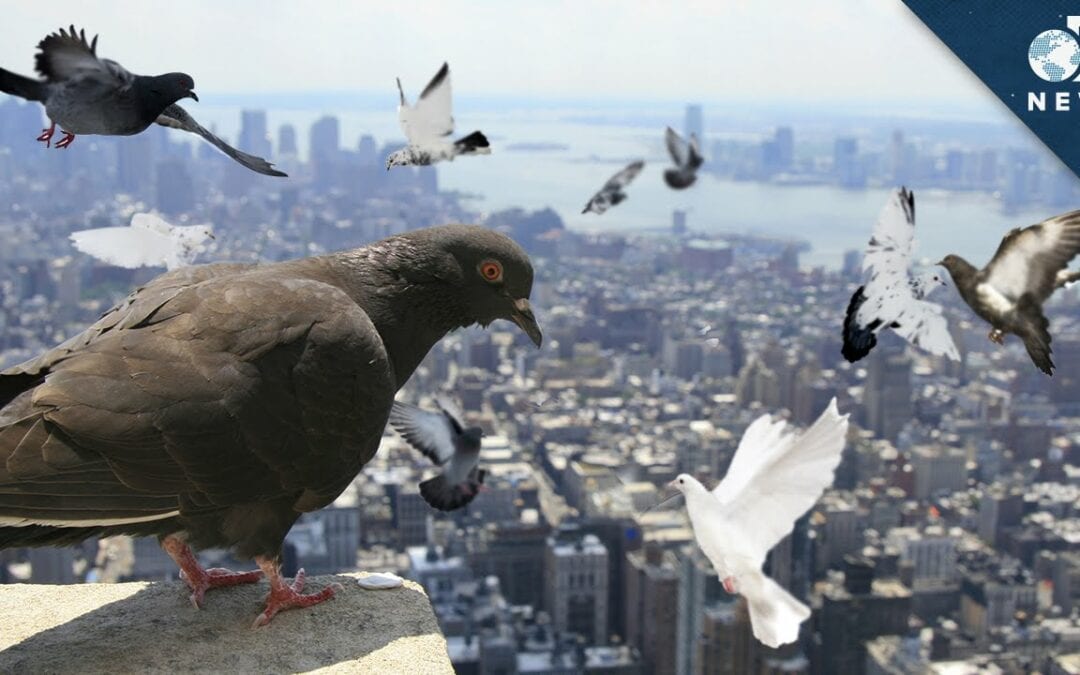
by Pigeon Patrol | May 25, 2021 | history of pigeons, pet bird, Pigeon Control, Pigeon Droppings, Pigeon Patrol's Services
Though they’re often described as “rats with wings” (a phrase popularized by the movie Stardust Memories), pigeons are actually pretty cool. From homing instincts to misleading rump feathers, here are 15 things you might not know about these avian adventurers.
1. THEY MIGHT BE THE FIRST DOMESTICATED BIRD.
The common city pigeon (Columba livia), also known as the rock pigeon, might be the first bird humankind ever domesticated. You can see them in art dating back as far as 4500 BCE in modern Iraq, and they’ve been a valuable source of food for thousands of years.
2. THEY WON OVER CHARLES DARWIN—AND NIKOLA TESLA.
Pigeon-breeding was a common hobby in Victorian England for everyone from well-off businessmen to average Joes, leading to some fantastically weird birds. Few hobbyists had more enthusiasm for the breeding process than Charles Darwin, who owned a diverse flock, joined London pigeon clubs, and hobnobbed with famous breeders. Darwin’s passion for the birds influenced his 1868 book The Variation of Animals and Plants Under Domestication, which has not one but two chapters about pigeons (dogs and cats share a single chapter).
Nikola Tesla was another great mind who enjoyed pigeons. He used to care for injured wild pigeons in his New York City hotel room. Hands down, Tesla’s favorite was a white female—about whom he once said, “I loved that pigeon, I loved her as a man loves a woman and she loved me. When she was ill, I knew and understood; she came to my room and I stayed beside her for days. I nursed her back to health. That pigeon was the joy of my life. If she needed me, nothing else mattered. As long as I had her, there was a purpose in my life.” Reportedly, he was inconsolable after she died.
3. THEY UNDERSTAND SPACE AND TIME.
In a 2017 Current Biology study, researchers showed captive pigeons a series of digital lines on a computer screen for either two or eight seconds. Some lines were short, measuring about 2.3 inches across; others were four times longer. The pigeons were trained to evaluate either the length of the line or how long it was displayed. They found that the more time a line was displayed, the longer in length the pigeon judged it to be. The reverse was true too: If the pigeons encountered a longer line, they thought it existed in time for a greater duration. Pigeons, the scientists concluded, understand the concepts of both time and space; the researchers noted “similar results have been found with humans and other primates.”
It’s thought that humans process those concepts with a brain region called the parietal cortex; pigeon brains lack that cortex, so they must have a different way of judging space and time.
4. THEY CAN FIND THEIR WAY BACK TO THE NEST FROM 1300 MILES AWAY.
The birds can do this even if they’ve been transported in isolation—with no visual, olfactory, or magnetic clues—while scientists rotate their cages so they don’t know what direction they’re traveling in. How they do this is a mystery, but people have been exploiting the pigeon’s navigational skills since at least 3000 BCE, when ancient peoples would set caged pigeons free and follow them to nearby land.
Their navigational skills also make pigeons great long-distance messengers. Sports fans in ancient Greece are said to have used trained pigeons to carry the results of the Ancient Olympics. Further east, Genghis Khan stayed in touch with his allies and enemies alike through a pigeon-based postal network.
5. THEY SAVED THOUSANDS OF HUMAN LIVES DURING WORLD WARS I AND II.
Pigeons’ homing talents continued to shape history during the 20th century. In both World Wars, rival nations had huge flocks of pigeon messengers. (America alone had 200,000 at its disposal in WWII.) By delivering critical updates, the avians saved thousands of human lives. One racing bird named Cher Ami completed a mission that led to the rescue of 194 stranded U.S. soldiers on October 4, 1918.
6. TWO PIGEONS ALMOST DISTRACTED FROM THE DISCOVERY OF EVIDENCE OF THE BIG BANG.
In 1964, scientists in Holmdel, New Jersey, heard hissing noises from their antenna that would later prove to be signals from the Big Bang. But when they first heard the sound, they thought it might be, among other things, the poop of two pigeons that were living in the antenna. “We took the pigeons, put them in a box, and mailed them as far away as we could in the company mail to a guy who fancied pigeons,” one of the scientists later recalled. “He looked at them and said these are junk pigeons and let them go and before long they were right back.” But the scientists were able to clean out the antenna and determine that they had not been the cause of the noise. The trap used to catch the birds (before they had to later be, uh, permanently removed) is on view at the Smithsonian Air & Space Museum.
7. YOU CAN TRAIN THEM TO BE ART SNOBS …
Japanese psychologist Shigeru Watanabe and two colleagues earned an Ig Nobel Prize in 1995 for training pigeons, in a lab setting, to recognize the paintings of Claude Monet and Pablo Picasso and to distinguish between the painters. The pigeons were even able to use their knowledge of impressionism and cubism to identify paintings of other artists in those movements. Later, Watanabe taught other pigeons to distinguish watercolor images from pastels. And in a 2009 experiment, captive pigeons he’d borrowed were shown almost two dozen paintings made by students at a Tokyo elementary school, and were taught which ones were considered “good” and which ones were considered “bad.” He then presented them with 10 new paintings and the avian critics managed to correctly guess which ones had earned bad grades from the school’s teacher and a panel of adults. Watanabe’s findings indicate that wild pigeons naturally categorize things on the basis of color, texture, and general appearance.
8. … AND TO DISTINGUISH WRITTEN WORDS.
In a 2016 study, scientists showed that pigeons can differentiate between strings of letters and actual words. Four of the birds built up a vocabulary of between 26 and 58 written English words, and though the birds couldn’t actually read them, they could identify visual patterns and therefore tell them apart. The birds could even identify words they hadn’t seen before.
9. FLUFFY PIGEON FEET MIGHT ACTUALLY BE PARTIAL WINGS.
A few pigeon breeds have fuzzy legs—which hobbyists call “muffs”—rather than scaly ones. According to a 2016 study, the DNA of these fluffy-footed pigeons leads their hind legs to take on some forelimb characteristics, making muffed pigeon legs look distinctly wing-like; they’re also big-boned. Not only do they have feathers, but the hindlimbs are somewhat big-boned, too. According to biologist Mike Shapiro, who led the study, “pigeons’ fancy feathered feet are partially wings.”
10. SOME PIGEONS DISTRACT FALCONS WITH WHITE RUMP FEATHERS.
In a life-or-death situation, a pigeon’s survival could depend upon its color pattern: Research has shown that wild falcons rarely go after pigeons that have a white patch of feathers just above the tail, and when the predators do target these birds, the attacks are rarely successful.
To figure out why this is, Ph.D. student Alberto Palleroni and a team tagged 5235 pigeons in the vicinity of Davis, California. Then, they monitored 1485 falcon-on-pigeon attacks over a seven-year span. The researchers found that although white-rumped pigeons comprised 20 to 25 percent of the area’s pigeon population, they represented less than 2 percent of all the observed pigeons that were killed by falcons; the vast majority of the victims had blue rumps. Palleroni and his team rounded up 756 white- and blue-rumped pigeons and swapped their rump feathers by clipping and pasting white feathers on blue rumps, and vice versa. The falcons had a much easier time spotting and catching the newly blue-rumped pigeons, while the pigeons that received the white feathers saw predation rates plummet.
Close observation revealed that the white patches distract birds of prey. In the wild, falcons dive-bomb other winged animals from above at high speeds. Some pigeons respond by rolling away in midair, and on a spiraling bird, white rump feathers can be eye-catching, which means that a patch of them may divert a hungry raptor’s focus long enough to make the carnivore miscalculate and zip right past its intended victim.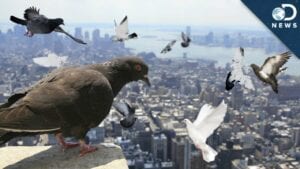
11. DODOS WERE RELATED TO TODAY’S PIGEONS.
Though most of this list focuses on the rock pigeon, there are 308 living species of pigeons and doves. Together, they make up an order of birds known as the columbiformes. The extinct dodo belonged to this group as well.
Flightless and (somewhat) docile, dodos once inhabited Mauritius, an island near Madagascar. The species had no natural predators, but when human sailors arrived with rats, dogs, cats, and pigs, it began to die out, and before the 17th century came to a close, the dodo had vanished altogether. DNA testing has confirmed that pigeons are closely related to the dodo, and the vibrant Nicobar pigeon (above) is its nearest genetic relative. A multi-colored bird with iridescent feathers, this near-threatened creature is found on small islands in the South Pacific and off Asia. Unlike the dodo, it can fly.
12. AT ONE POINT, MORE THAN ONE-QUARTER OF ALL THE BIRDS LIVING IN THE U.S. MAY HAVE BEEN PASSENGER PIGEONS.
Wild/feral rock pigeons reside in all 50 states, which makes it easy to forget that they’re invasive birds. Originally native to Eurasia and northern Africa, the species was (most likely) introduced to North America by French settlers in 1606. At the time, a different kind of columbiform—this one indigenous—was already thriving there: the passenger pigeon (Ectopistes migratorius). As many as 5 billion of them were living in America when England, Spain, and France first started colonizing, and they may have once represented anywhere from 25 to 40 percent of the total U.S. bird population. But by the early 20th century, they had become a rare sight, thanks to overhunting, habitat loss, and a possible genetic diversity issue. The last known passenger pigeon—a captive female named Martha—died on September 1, 1914.
13. THEY’RE REALLY GOOD AT MULTITASKING.
According to one study, they’re more efficient multitaskers than people are. Scientists at Ruhr-Universitat Bochum put together a test group of 15 humans and 12 pigeons and trained all of them to complete two simple jobs (like pressing a keyboard once a light bulb came on). They were also put in situations wherein they’d need to stop working on one job and switch over to another. In some trials, the participants had to make the change immediately. During these test runs, humans and pigeons switched between jobs at the same speed.
But in other trials, the test subjects were allowed to complete one assignment and then had to wait 300 milliseconds before moving on to the next job. Interestingly, in these runs, the pigeons were quicker to get started on that second task after the period ended. In the avian brain, nerve cells are more densely packed, which might enable our feathered friends to process information faster than we can under the right circumstances.
14. PIGEONS PRODUCE FAKE “MILK.”
Only mammals produce genuine milk, but pigeons and doves (along with some other species of birds) feed their young with something similar—a whitish liquid filled with nutrients, fats, antioxidants, and healthy proteins called “crop milk.” Both male and female pigeons create the milk in the crop, a section of the esophagus designed to store food temporarily. As is the case with mammal milk, the creation of crop milk is regulated by the hormone prolactin. Newly-hatched pigeons drink crop milk until they’re weaned off it after four weeks or so. (And if you’ve ever asked yourself, “Where are all the baby pigeons?” we have the answer for you right here.)
15. ONE STUDY SUGGESTS THAT, GIVEN THE RIGHT CONDITIONS, THEY’RE AS GOOD AT IDENTIFYING CANCER AS DOCTORS.
We’ve already established that pigeons are excellent at differentiating between artists and words, but a 2015 study revealed they can also distinguish between malignant and benign growths in the right conditions. Researchers at University of California Davis Medical Center put 16 pigeons in a room with magnified biopsies of potential breast cancers. If the pigeons correctly identified them as either benign or malignant, they got a treat, According to Scientific American.
“Once trained, the pigeons’ average diagnostic accuracy reached an impressive 85 percent. But when a “flock sourcing” approach was taken, in which the most common answer among all subjects was used, group accuracy climbed to a staggering 99 percent, or what would be expected from a pathologist. The pigeons were also able to apply their knowledge to novel images, showing the findings weren’t simply a result of rote memorization.”
Mammograms proved to be more of a challenge, however; the birds could memorize signs of cancer in the images they were trained on but could not identify the signs in new images.
No matter how impressive their results, “I don’t anticipate that pigeons, no matter how good they become at pathology or radiology, will be playing a role in actual patient care—certainly for the foreseeable future,” study co-author Richard M. Levenson told Scientific American. “There are just too many regulatory barriers—at least in the West.”
Source
Pigeon Patrol Products & Services is the leading manufacturer and distributor of bird deterrent (control) products in Canada. Pigeon Patrol products have solved pest bird problems in industrial, commercial, and residential settings since 2000, by using safe and humane bird deterrents with only bird and animal friendly solutions. At Pigeon Patrol, we manufacture and offer a variety of bird deterrents, ranging from Ultra-flex Bird Spikes with UV protection, Bird Netting, 4-S Bird Gel and the best Ultrasonic and audible sound devices on the market today.
Voted Best Canadian wholesaler for Bird Deterrent products ten years in a row.
Contact us at 1- 877– 4– NO-BIRD, (604) 585-9279 or visit our website at www.pigeonpatrol.ca
Pigeon/Pigeon Patrol / Pigeons Roosting / Vancouver Pigeon Control /Bird Spikes / Bird Control / Bird Deterrent / Pigeon Deterrent? Surrey Pigeon Control / Pest /Seagull deterrent / Vancouver Pigeon Blog / Birds Inside Home / Pigeons in the cities / Ice Pigeons/ What to do about pigeons/ sparrows , Damage by Sparrows, How To Keep Raccoons Away, Why Are Raccoons Considered Pests/ De-fence / Pigeon Nesting/ Bird Droppings / Pigeon Dropping/ woodpecker control/ Professional Bird Control Company/ Keep The Birds Away/ Birds/rats/ seagull/pigeon/woodpecker/ dove/sparrow/pidgeon control/pidgeon problem/ pidgeon control/flying rats/ pigeon Problems/ bird netting/bird gel/bird spray/bird nails/ bird guard
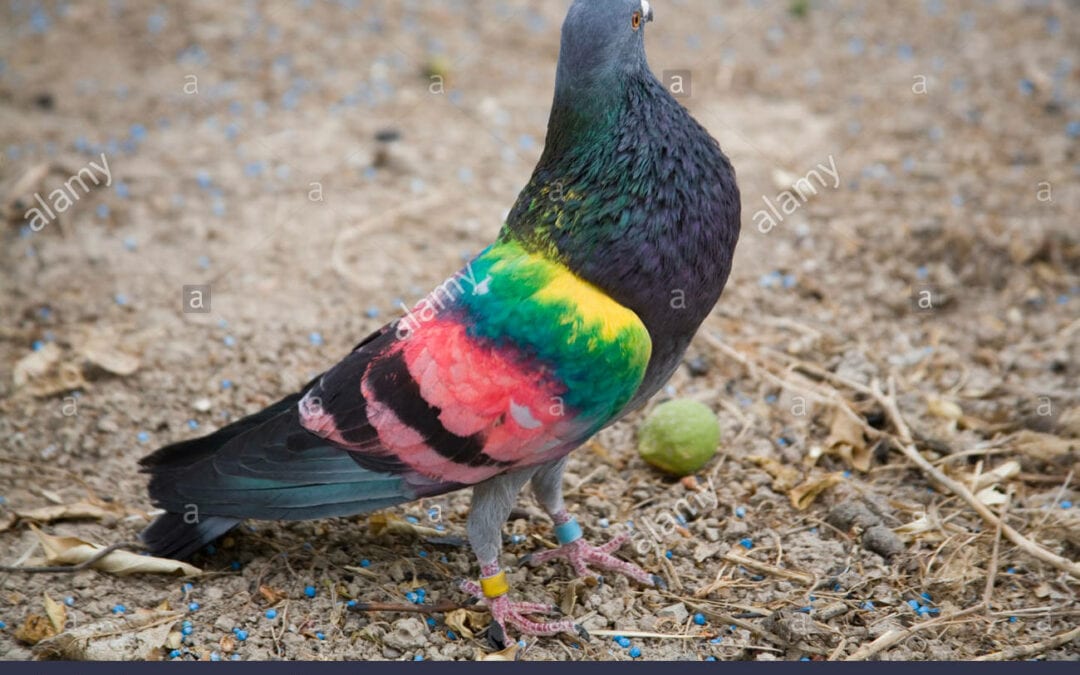
by Pigeon Patrol | May 17, 2021 | Bird Law, Doves, history of pigeons, pet bird, Pigeon Control
Earth’s magnetic field plays a vital role in everything from animal migration to protecting the Earth from the Sun’s harsh solar wind. Now, a recent study finally sheds light on how some birds visually see Earth’s magnetic field. Birds use Earth’s magnetic field as sort of a heads-up display to help them navigate the globe.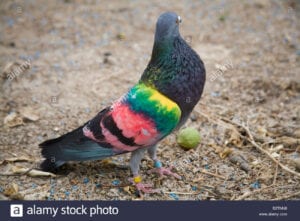
The Earth’s magnetic field is a result of the movement or convection of liquid iron in the outer core. As the liquid metal in the outer core moves, it generates electric currents, which lead to a magnetic field. The continual movement of liquid metal through this magnetic field creates stronger electrical currents and thus a stronger magnetic field. This positive feedback loop is called the geomagnetic dynamo.
While scientists have known for quite some time that birds can see Earth’s magnetic field, it was unclear exactly how birds are able to visualize the magnetic field. Two recent studies from researchers at Lund University in Sweden and Carl von Ossietzky University Oldenburg in Germany discovered that the ability is a result of a special protein in bird’s eyes. The two papers studied European robins and zebra finches and found evidence for an unusual eye protein called Cry4.
The Cry4 protein is part of a class of protein called a cryptochrome that is sensitive to blue light. Cryptochromes are found in both plants and animals and are responsible for circadian rhythms in various species. In the two bird species above, it appears that the presence of cryptochromes, specifically the Cry4 protein, is responsible for the ability of birds to visually detect Earth’s magnetic field.
The ability to see Earth’s magnetic field, known as magnetoreception, relies on the presence of specifically the blue wavelength of light. The complex process involves “radical” intermediate molecules which are sensitive to Earth’s magnetic field. The Earth’s magnetic field, as it relates to the direction the bird is facing, could alter the intermediate radical molecules differently, giving the bird a sense for where it is facing in relation to the Earth’s magnetic field.
The research team also found that the Cry4 protein was produced in much higher amounts in European robins during migration season. Perhaps this would give the robin a more precise picture of Earth’s magnetic field throughout its migration.
While the exact way birds visualize Earth’s magnetic field is part of further investigation, scientists believe the Cry4 protein acts as sort of a filter over the bird’s vision. This filter would allow birds to see a sort of compass of the Earth and direct their migratory flights accordingly.
Scientists at the University of Illinois at Urbana-Champaign believe birds see Earth’s magnetic field through a filter similar to the figure above. This would act to guide birds in the right direction through migration.
Source
Pigeon Patrol Products & Services is the leading manufacturer and distributor of bird deterrent (control) products in Canada. Pigeon Patrol products have solved pest bird problems in industrial, commercial, and residential settings since 2000, by using safe and humane bird deterrents with only bird and animal friendly solutions. At Pigeon Patrol, we manufacture and offer a variety of bird deterrents, ranging from Ultra-flex Bird Spikes with UV protection, Bird Netting, 4-S Bird Gel and the best Ultrasonic and audible sound devices on the market today.
Voted Best Canadian wholesaler for Bird Deterrent products ten years in a row.
Contact us at 1- 877– 4– NO-BIRD, (604) 585-9279 or visit our website at www.pigeonpatrol.ca
Pigeon/Pigeon Patrol / Pigeons Roosting / Vancouver Pigeon Control /Bird Spikes / Bird Control / Bird Deterrent / Pigeon Deterrent? Surrey Pigeon Control / Pest /Seagull deterrent / Vancouver Pigeon Blog / Birds Inside Home / Pigeons in the cities / Ice Pigeons/ What to do about pigeons/ sparrows , Damage by Sparrows, How To Keep Raccoons Away, Why Are Raccoons Considered Pests/ De-fence / Pigeon Nesting/ Bird Droppings / Pigeon Dropping/ woodpecker control/ Professional Bird Control Company/ Keep The Birds Away/ Birds/rats/ seagull/pigeon/woodpecker/ dove/sparrow/pidgeon control/pidgeon problem/ pidgeon control/flying rats/ pigeon Problems/ bird netting/bird gel/bird spray/bird nails/ bird guard

by Pigeon Patrol | May 17, 2021 | Bird Netting, Bird Spikes, Pigeon Control, Pigeon Droppings
Pigeons are easily recognizable by their distinct coloring. With their white-gray rump, iridescent facial feathers and black stripes on their tails and wings, these birds are easy to identify. Pigeons reproduce incredibly quickly, and mating occurs year round. Despite their speedy reproduction rates, pigeons are monogamous creatures that lay one or two eggs at a time, which hatch within 18 days. Baby pigeons are fed “pigeon milk,” or regurgitated food, by both their parents until they are old enough to find food on their own.
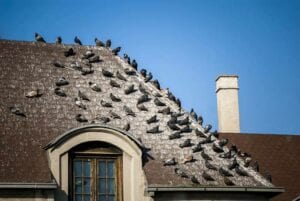
Pigeon Habits
Pigeons prefer grains, but they are not picky when it comes to their meals. Much of their diet comes from humans who drop or spill their food, or place leftovers in open trash cans that pigeons can scavenge. These birds like to hang out on ledges and other narrow areas high above the ground. They like to roost in covered, high areas, and their nests can frequently be found in places like steeples or under bridges.
Pigeon Habitats
Pigeons are true city dwellers who are dependent on humans to provide food, roosting and nesting sites. This is why you often see them gathered around city parks, buildings and bridges. Pigeons are also commonly found around agricultural areas, as well as warehouses, feed mills and grain elevators.
Pigeon Threats
Often called the “rats of the sky,” pigeons can be incredibly problematic. These birds can carry dangerous diseases like cryptococcosis, toxoplasmosis, salmonella, food poisoning and more. Their droppings may also harbor the growth of fungus, which causes histoplasmosis, which can accelerate the aging of structures and statues. Even more alarming, these social birds often serve as unwitting hosts to fleas, lice, mites, ticks and other pests, which can create secondary infestations.
Signs You Have a Pigeon Infestation
The most obvious sign of a pigeon infestation is the presence of many birds, pigeon nests or their droppings.
How To Prevent an Infestation
The best way to prevent pigeons from roosting in or near your house is to make your home undesirable. Remove any and all food they could get access to, place pointy objects on pigeon-friendly surfaces and place nets across open areas.
How to Get Rid of Pigeons
The steps for pigeon removal and prevention are the same: make their living space uninhabitable. Killing pigeons is not effective and it will not root out the source of the problem. Instead, eliminate all food sources and remove their nests and replace them with objects that prevent them from returning.
Source
Pigeon Patrol Products & Services is the leading manufacturer and distributor of bird deterrent (control) products in Canada. Pigeon Patrol products have solved pest bird problems in industrial, commercial, and residential settings since 2000, by using safe and humane bird deterrents with only bird and animal friendly solutions. At Pigeon Patrol, we manufacture and offer a variety of bird deterrents, ranging from Ultra-flex Bird Spikes with UV protection, Bird Netting, 4-S Bird Gel and the best Ultrasonic and audible sound devices on the market today.
Voted Best Canadian wholesaler for Bird Deterrent products ten years in a row.
Contact us at 1- 877– 4– NO-BIRD, (604) 585-9279 or visit our website at www.pigeonpatrol.ca
Pigeon/Pigeon Patrol / Pigeons Roosting / Vancouver Pigeon Control /Bird Spikes / Bird Control / Bird Deterrent / Pigeon Deterrent? Surrey Pigeon Control / Pest /Seagull deterrent / Vancouver Pigeon Blog / Birds Inside Home / Pigeons in the cities / Ice Pigeons/ What to do about pigeons/ sparrows , Damage by Sparrows, How To Keep Raccoons Away, Why Are Raccoons Considered Pests/ De-fence / Pigeon Nesting/ Bird Droppings / Pigeon Dropping/ woodpecker control/ Professional Bird Control Company/ Keep The Birds Away/ Birds/rats/ seagull/pigeon/woodpecker/ dove/sparrow/pidgeon control/pidgeon problem/ pidgeon control/flying rats/ pigeon Problems/ bird netting/bird gel/bird spray/bird nails/ bird guard

by Pigeon Patrol | May 10, 2021 | Bird Law, Bird Spikes, Pigeon Control, Pigeon Droppings, Pigeon Patrol's Services
Color of Pigeons
Usually bluish-gray with black bands and reddish feet.
What does a pigeon look like?
Pigeons have broad and pointed wings, with small heads and short legs. They also have a wide and rounded tail. Their coat is blueish grey. They have a soft voice with guttural series of rolling coos.
Where are pigeons found?
Originally found wild in Europe, North Africa, and western Asia, feral pigeons have become established in cities around the world. The lack of adequate sanitation, deliberate feeding of the birds by humans, and “cliff-type” nesting sites on older buildings are the principal factors that attract pigeons to cities.
They will inhabit roofs, ledges, drain spouts, lofts, attics, caves, etc. They also frequent parks and sidewalks, where they become habituated to people feeding them. Pigeons are mainly creatures of habit and tend to feed, nest, and roost in the same place day after day.
Pigeons are a pest in most urban areas in the US. On the West Coast our local pest control specialists find pigeons affect many of our customers in cities such as Boise, Roseburg, Salinas, Spokane, Novato, and Palm Springs.
What do pigeons eat?
These bird-brained beauties also eat livestock manure; they’re not picky, and actually pretty disgusting. (But please don’t feed the birds. They do carry diseases.) Other favorite treats include seeds, grains, some fruits and green feed; but will feed on insects.
Pigeon life span
Pigeons pair for life, which may last for 15 years or longer. In urban environments, they may live for 3-4 years. Pigeons have a hearing range close to humans, but they have a poor sense of taste and smell. Remember—they eat manure. They also exhibit distinct behavioral patterns like nesting, feeding, roosting, and loafing. Nesting and roosting sites (places where they sleep or rest) may occur in the same area or be as far as 5 miles apart.
Breeding occurs year-round with 1-2 eggs per batch. The eggs hatch after 17-19 days of incubation, and young pigeons will leave the nest after 4 to 6 weeks. More eggs may be laid before the first young are gone. An adult pigeon eats about one pound of food a week. Pigeons, their nests, and droppings are of major concern because 50 or more diseases and ectoparasites are associated with them.
Diseases spread by pigeons
Pigeons are of great medical concern because more than 50 diseases and ectoparasites are associated with them, which leads to their description by non-romantics as flying rodents. Pigeon nests and droppings will also lead to dermestid beetles, flies, clothes moths, and stored product pest infestations within buildings.
-
Asthma – bird dropping can dry up and become dust. Once inhaled, this can trigger asthma attacks.
-
Salmonella – also known as food poisoning, but droppings can lead to the contamination of food.
-
Listeriosis, histoplasmosis, cryptococcosis – all fungal diseases that can come from growing on pigeon droppings.
-
Diseases from parasites – pigeons often carry ticks and fleas which can lead to things like Lyme disease and other illnesses associated with those pests.
Signs of a pigeon problem
How do you know if you have just a few pigeons or if you have a serious problem? Well, there are signs that the pigeons around your property may be causing problems. They include:
-
Large numbers of birds – just take a look around your property and see how many pigeons there are. Once one decides to set up shop, others are likely to follow. Are there a lot of birds on the ground? Are there more roosting above? Are people having trouble just walking through the area because of the number of birds?
-
Nesting material – pigeons use sticks, twigs, branches, leaves and even garbage to make up their nests. Is there an increased number of this material lying around? Pigeons are not famous for their neatness, so if there is an increase of debris, it could be from too many pigeons trying to nest.
-
Droppings – pigeons are rather notorious for the deposits that they leave behind. Are there so many that it makes it hard to walk? If so, time to call in the pros.
How to keep pigeons away
Got pigeon issues? Due to the problems that can come with these birds, you should have an infestation addressed right away. There are ways to keep pigeons away, such as spikes. Read more about these techniques below. Plus, you should make sure pigeons cannot get to standing water or food on your property. Get rid of garbage or food that has been spilled, so pigeons may find a spot less appealing.
Pigeon control methods
There are many techniques for excluding pigeons from an infested structure. Exclusion strategies include structural modification, bird netting, plastic and metal spikes, monofilament and steel lines, and trapping. In addition, gels, paste, and liquids can also be used for excluding the birds from the structure.
Structural modification: Birds like to land on flat surfaces. When the building ledges are angled (45 degrees), it prevents birds from landing on building edges. Sheet metals, styrofoam blocks, wood, stone, and other materials can be used to give the desired angle.
Bird netting: There are several types of bird nettings that can be used for exclusion. In general, netting provides the best long-term control in keeping the birds out of a structure. In warehouses and commercial buildings where bird activity is a major concern, bird nets can be used to prevent the birds from getting into overhead pipes, roof air conditioning units can be netted off from the birds, etc.
Plastic and metal spikes: Spikes can be used as a physical barrier in preventing the birds from landing on an area, such as perching on ledges and beams of buildings. Spikes have sharp pointed edges extending out at angles. They can be installed around ledges, roof peaks, eaves, window sills, or any places that are prone to roosting. Because netting and spikes are more effective long-term control methods, they are the preferred methods.
Pigeon repellent
Pigeon repellents are available in different formulations such as gel, paste and liquids. They differ considerably in cost, effectiveness, and texture (thick and tacky, jelly like or viscous).
Choose the one that works best based on the experience. These repellents are not non-toxic and because of their “sticky” properties cause the birds to move elsewhere.
How to get rid of pigeons
If you’re dealing with pigeons, you should contact a pest professional to figure out how to eliminate these pests. As you may have noticed, pigeons can get droppings on buildings, damaging the appearance of these structures. Their droppings can also pollute zones of human activity as well as food. A Western Exterminator expert can ascertain how to handle the situation and help you know how to inhibit these birds for the future.
Bird control solutions from Western Exterminator
Pigeons aren’t the only birds home and business owners need to be concerned about. Seagulls and starlings are known to cause damage and spread disease as well. With proper identification, our specialists can create bird control plans specifically made for you to ensure your property is bird-free.
Pigeon Patrol Products & Services is the leading manufacturer and distributor of bird deterrent (control) products in Canada. Pigeon Patrol products have solved pest bird problems in industrial, commercial, and residential settings since 2000, by using safe and humane bird deterrents with only bird and animal friendly solutions. At Pigeon Patrol, we manufacture and offer a variety of bird deterrents, ranging from Ultra-flex Bird Spikes with UV protection, Bird Netting, 4-S Bird Gel and the best Ultrasonic and audible sound devices on the market today.
Voted Best Canadian wholesaler for Bird Deterrent products ten years in a row.
Contact us at 1- 877– 4– NO-BIRD, (604) 585-9279 or visit our website at www.pigeonpatrol.ca
Pigeon/Pigeon Patrol / Pigeons Roosting / Vancouver Pigeon Control /Bird Spikes / Bird Control / Bird Deterrent / Pigeon Deterrent? Surrey Pigeon Control / Pest /Seagull deterrent / Vancouver Pigeon Blog / Birds Inside Home / Pigeons in the cities / Ice Pigeons/ What to do about pigeons/ sparrows , Damage by Sparrows, How To Keep Raccoons Away, Why Are Raccoons Considered Pests/ De-fence / Pigeon Nesting/ Bird Droppings / Pigeon Dropping/ woodpecker control/ Professional Bird Control Company/ Keep The Birds Away/ Birds/rats/ seagull/pigeon/woodpecker/ dove/sparrow/pidgeon control/pidgeon problem/ pidgeon control/flying rats/ pigeon Problems/ bird netting/bird gel/bird spray/bird nails/ bird guard


